Table of Contents
- Where Green Tea Comes From and How It Is Processed
- How Much Caffeine Is in Green Tea?
- How to Brew Green Tea to Reduce Caffeine
- How to Drink Green Tea
- How Many Calories in Green Tea
- Health Benefits of Green Tea - What Is Green Tea Good For?
- Green Tea Makes You Happy
- Green Tea Is Full of Antioxidants
- Green Tea Can Improve Physical Performance
- What Is the Best Time to Drink Green Tea?
- Green Tea Quality Matters
Where Green Tea Comes From and How It Is Processed

Green tea, just like black, white, oolong, and pu-erh teas, comes from the leaves and buds of the Camellia sinensis plant, although it is processed a little differently. Unlike black and oolong tea, which undergo an oxidation process, green tea is quickly heated and dried to avoid any oxidation, resulting in a brighter green leaf and light, grassy brew.
All Tielka's organic green teas feature Tielka's signature handcrafted organic green tea from the high-mountain regions of the Hubei Province in China, a varietal known as Wulu, literally "jade". (Check out Tielka's award-winning Jade Mist collection of pyramid infusers, you won't be disappointed.)
How Much Caffeine Is in Green Tea
Green tea is typically considered "low" in caffeine, even lower than black tea. One cup of green tea contains, on average, 25mg of caffeine, compared to black tea that contains around 44mg of caffeine.
How to Brew Green Tea to Reduce Caffeine
Your brewing technique will significantly alter the amount of caffeine in your cup of tea. A rule of thumb is that the longer and hotter you brew your green tea leaves, the more caffeine will be left in your cup.
Ideally, you should brew your green tea at 70°C (158 °F). It will not only taste better, but there will also be less caffeine than if you brew at boiling point. And if you like your tea stronger, but want to avoid caffeine at the same time, add a little more tea leaves and shorten your brew to around 1 minute.
Another way to reduce your caffeine intake, but still enjoy green tea, is to drink a green tea blend, for example, Tielka's Rose Moscato Green Tea or Tielka's Persian Mint Chai Green Tea. These two varieties are blended with caffeine-free herbs and spices, so there will be less caffeine in your cup than a cup of pure green tea.
The good news about caffeine in tea is that it doesn't give you the jitters as coffee does. This is due to the lower levels of caffeine and the addition of L-Theanine, an amino acid in green tea that improves brain function and promotes a state of calm.
How to Drink Green Tea

Green tea is best enjoyed without any milk or sugar, as the flavours are so delicate and intricate, any addition would spoil the experience. Green tea can also be enjoyed iced, although a green tea blend will produce the most pleasant brew - check Tielka's Rose Moscato Green Tea.
How Many Calories in Green Tea
There are ZERO calories in pure green tea! You can enjoy countless cups of green tea without having to worry about adding any extra calories.
Watch out for commercially made iced green tea options, these are usually full of sugar and will significantly increase your calorie intake.
Health Benefits of Green Tea - What Is Green Tea Good for?
The list of health effects of green tea is endless!
Green Tea Makes You Happy

Our favourite benefit is that green tea makes you feel happy! Green tea contains L-Theanine, which is an amino acid that increases dopamine levels and the production of alpha waves in the brain. It's no wonder your world feels like such a better place after a cup of green tea! And L-Theanine doesn't just make you feel happy, it has anti-anxiety effects and consistently leads to improvements in various aspects of brain function, including vigilance, reaction time and memory.
Green Tea Is Full of Antioxidants
Green tea is also around 30% polyphenols by weight, including large amounts of a catechin called epigallocatechin-3-gallate (EGCG). EGCG is the major polyphenolic compound present in green tea, has shown numerous cardiovascular health-promoting activity through modulating various pathways. Catechins are natural antioxidants that help prevent cell damage and provide numerous benefits like reducing inflammation, aiding weight loss, and helping prevent cancer, heart and brain disease.
Green Tea Can Improve Physical Performance

Green tea can also improve physical performance and help burn more fat.
Numerous studies indicate a positive link between fat burning and green tea consumption. In one study, drinking green tea resulted in a significant increase in energy expenditure. Another study showed that fat oxidation was increased by 17%.
Caffeine, which is present in green tea, is another factor in improving physical performance by mobilizing fatty acids from the fat tissues and making them available for use as energy.
In two separate studies (Caffeine Use in Sports and The Effects of Preexercise Caffeinated Coffee Ingestion on Endurance Performance), caffeine consumption resulted in an increase in physical performance by 11-12% on average.
The list of benefits from drinking green tea is endless from lowering your risk of cancer, Alzheimer's and Parkinson's, improving dental health, lowering your risk of type 2 diabetes, cardiovascular disease and help you live longer.
What Is the Best Time to Drink Green Tea?

The best time of day to drink tea is morning, early afternoon, and just before any intense physical activity, e.g. workout at the gym.
Drinking green tea in the evening may result in sleeplessness due to the caffeine content, so the benefits of improved brain function and physical performance are best reserved for other times of the day.
Green Tea Quality Matters
One thing to note, it's really important you choose a good quality green tea, as low-quality green teas available in the supermarkets today can contain excessive amounts of fluoride.
We recommend Tielka's Jade Mist Green Tea, a handcrafted green tea, harvested in the spring in the Hubei Province of China.
Happy brewing!


